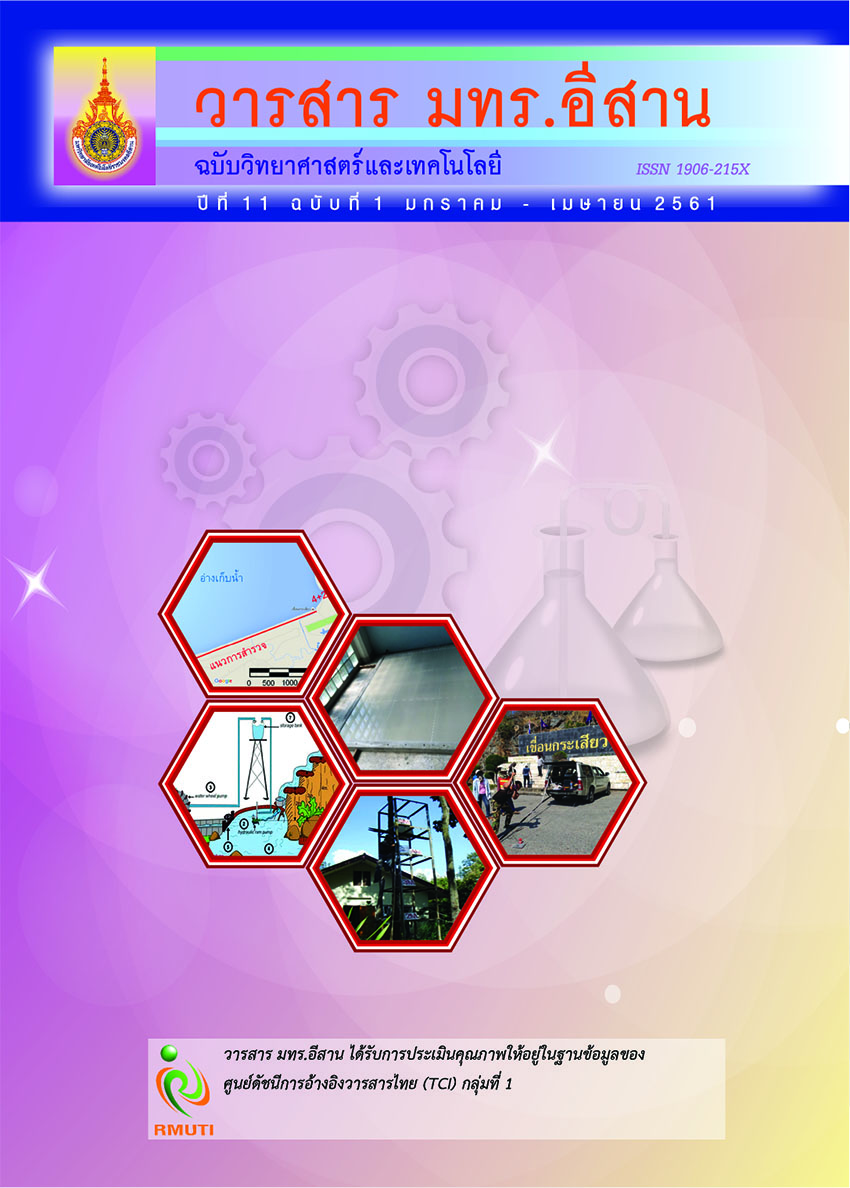Hybrid Water Pumping System for Natural Water Resources
Main Article Content
Abstract
The main goal of this paper was to develop the appropriate water pumping system for natural
water sources in Northern Thailand. Optimal pumping volume fl owrate and head was the target
of the water pumping system development. Three types of pumping systems were evaluated
with the prototype water sources, namely, Hydraulic Ram Pump (H.R.P.), Water Wheel Pump
(W.W.P.) and Hybrid Water Pump (H.W.P.). For the overall performance, H.R.P. and W.W.P.
provided delivery head of 3 - 13 m, evaluated with the prototype waterfall and stream.
The inlet fl owrate had little eff ect on H.R.P., because higher inlet fl owrate resulted in higher
water loss without discharge increased. However, when the inlet fl owrate was less than 100 L/min,
H.R.P. was not be able to pump water. When the supply head increased from 2 to 5 m, the
discharge and delivery head also increased signifi cantly. For the W.W.P., the supply head of
the waterfall did not aff ect the performance of the pump. The appropriate operating velocity
were at 0.5 - 1.5 m/s to yield discharge of 10 - 14 L/min which was higher than H.R.P.
by 1 - 13 L/min. Greater velocity than 1.5 m/s could not provide higher discharge or
delivery head.The performance of H.W.P. was the combination of the performance from
H.R.P. and W.W.P. The waste water from the H.R.P. would be reused for the W.W.P. with the
combined H.W.P. system. Therefore, the natural water could then be fully utilized. H.W.P.
could be used in the remote area without electricity access. The natural water pumps could be
operated continuously and use clean energy from nature. This system could be used in other
applications such as maintaining the watershed, creating moisture in the forest, preventing
forest fi re, and treating air and waste water.
Article Details
References
Majesty the King. Graphico Systems Company Limited
[2] Department of Energy. (1993). Energy Industry Department of Energy Development and
Promotion. Bangkok: Thammasat Printing House (in Thai)
[3] Shuaibu Ndachhe Mohammed. (2007). Design and Construction of Hydraulic Ram Pump.
Department of Mechanical Engineering, Federal University of Technology, Minna, Nigeria
[4] Suwannasit, N. (2000). Design and Development Hydraulic Ram Pump. Department of
Mechanical Engineering Rajamangala University of Technology Lanna (in Thai)
[5] Junprasert, E., Neuron, N., and Ginrid, B. (2003). Study Performance Hydraulic Ram pump.
Department of Mechanical Engineering Rajamangala University of Technology Lanna (in Thai)
[6] Gusri Akhyar Ibrahim, C. H., Cheharon, C. H., and UsnaAzhari. (2011). Traditional Water
Wheel in Padang. Malaysia: Department of Mechanical Engineering, University Kebangsaam
[7] Morgan, P. (1984). A Spiral Tube Water Wheel Pump. Blair Research Bulletin of Zimbabwe’s
Ministry of Health.
[8] Kummoon, D. and Kongngen, Y. (2009). Study Performance Spiral Tubing Vertically Coil
Pump. ChiangMai: Department of Mechanical Engineering, Rajamangala University of
Technology Lanna (in Thai)
[9] Niyomvas, B. and Potakarat, B. (2012). The Study Performance Hydraulic Ram Pump.
Department of Mechanical Engineering, Rajamangala University of Technology Srivichai (in Thai)
[10] Payathep, T. and Chairuen, P. (2008). Design and Development of Turbines for Low-Rise
Buoys. ChiangMai Rajamangala University of Technology Lanna (in Thai)


